If you want to get the most lively landscape, then the aquarium with barbs is what you need. More fussy fish are hard to find. Constant games with each other stop only when the lights in the aquarium are turned off. They are also very hardy and easy to breed, making them ideal for beginners. Watching these lively and playful fish brings only positive emotions.
General information
Barbs are ray-finned fishes from the Carp family. Due to their unpretentiousness, medium-size, and interesting colors, they are widespread in the aquarium hobby. This combined group includes several genera. Predominantly gregarious species that easily adapt to a variety of habitats. In addition to natural colors, there are breeding forms and fluorescent fish (GloFish).
They are famous as aquarium “bullies”, some aquarists even consider them to be predatory fish. But in reality, interspecific aggression in most cases is associated with errors in the keeping of fish (a too-small number of individuals in a group, incorrectly selected neighbors).
Appearance
All barbs have an elongated, slightly elongated body with a pointed front part. Sizes range from 5 to 35 cm, depending on the species. The caudal fin is two-lobed. The color of the scales depends on the specific species and is very diverse: you can find monophonic colors, with spots, transverse and longitudinal stripes. Gender dimorphism is weak in most species. Females are usually larger, with a large rounded abdomen, but less intense coloration than males.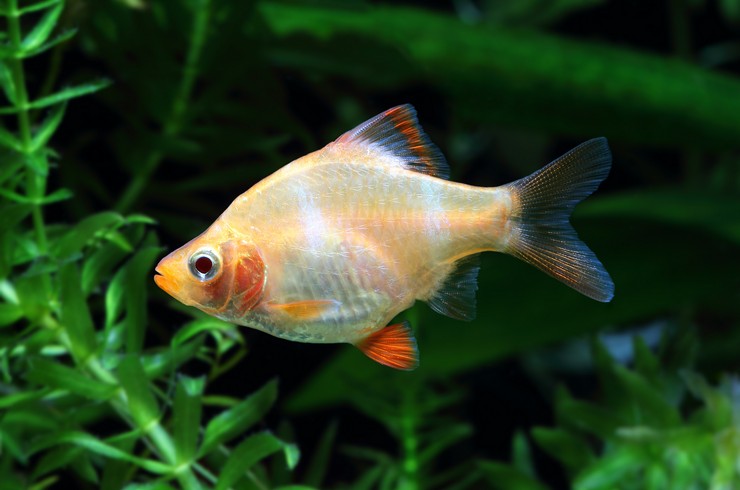
Habitat
Barbs are quite widespread in the equatorial and tropical parts of the planet. Most of the species originate from Southwest Asia (Borneo, Sumatra, Thailand, Cambodia). Some of them live in India and the island of Sri Lanka. Barbs are found in equatorial Africa.
Wild populations of barbs were brought to some countries and, thanks to their endurance, took root here without any problems. For example, some species can be found in the USA, Colombia, Australia, Singapore.
Care and maintenance
The volume of the aquarium for keeping barbs depends on the species and can range from 30 to 300 liters, preferably if it is extended in length. The presence of a cover is required – fish that are active by nature can easily jump out of the aquarium. Barbs are schooling fish, it is recommended to keep at least 6-10 individuals. Otherwise, they become more aggressive and capable of attacking neighbors in the aquarium.
The aquarium must have areas with dense thickets of plants and open areas for swimming. It is better to choose sand or small pebbles as soil, preferably a dark one. The most suitable decorations will be natural driftwood and stones.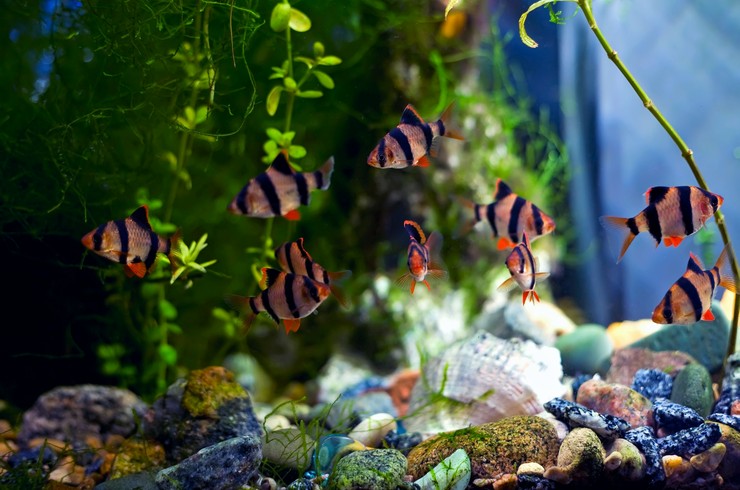
In the aquarium, good filtration and aeration must be organized. Some species like strong currents.
Compatibility
Barbs are a relatively peaceful species, they get along well with most species of ornamental fish. The only exceptions are fish with veil fins (especially clumsy golden ones) and long “whiskers” (gourami, lalius). It is very important to keep barbs in a flock of at least 6 individuals. If barbs are kept singly or in pairs, then the level of their aggression increases and then many fish may suffer from them.
Ideal for a community aquarium is to pick up several flocks of different types of barbs. But for a change, you can plant mollies, platies, danios, iris, peaceful catfish to them.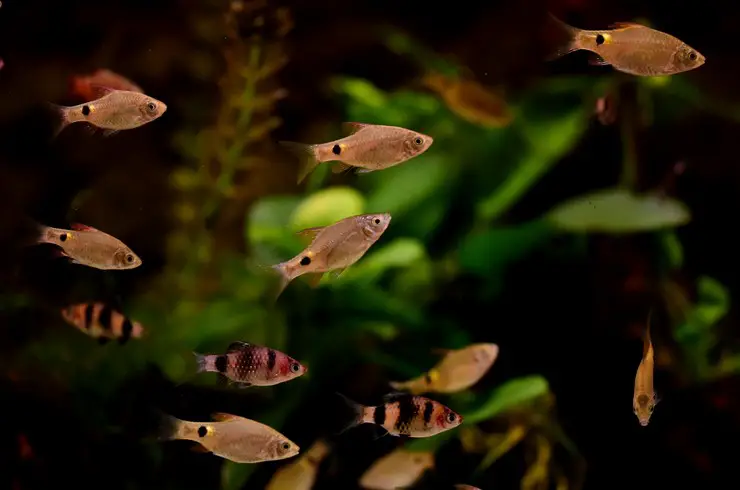
It is noted that grown barbs can live with large cichlids, but even they sometimes manage to pinch their fins.
Feeding barbs
Under natural conditions, all barbs are omnivorous. Their diet includes insects, larvae, worms, diatoms, small invertebrates, and detritus. They also like to pinch the tender parts of aquatic plants.
It is often suggested to feed barbs with live and frozen food, but remember that this carries the risk of contaminating the aquarium with dangerous infections and parasites, moreover, these types of food are deficient, so the fish do not receive the required amount of nutrients and vitamins.
It is best to feed your fish with high-quality dry food – this is the key to good health, longevity, and activity of your pets. I can take food barbs in all layers of the aquarium, but they prefer the surface and middle layers. The following dry foods are great:
- TetraMin Flakes is a universal flake food for all ornamental fish. It is made from more than 40 types of selected raw materials, contains all the necessary nutrients and vitamins, as well as probiotics to improve the digestive tract. The high digestibility of the feed reduces the amount of fish waste, therefore, the water stays clean longer.
- TetraPro Energy high-energy chips are specially designed for active fish. They are made using a gentle low-temperature technology, which allows you to keep even more nutrients in the feed.
- Tetra Phyll and TetraPro Algae feeds will enrich the barbs’ diet with a very important plant component, which will have a positive effect on health and longevity.
- To enhance the natural coloration of red, yellow, and orange barbs, use foods with natural color enhancers – Tetra Rubin or TetraPro Color. The result is noticeable after two weeks of regular feeding.
It is necessary to feed barbs several times a day with a portion of feed, which will be eaten in a few minutes. Fish are prone to overeating, it is recommended to arrange a “fasting day” once a week.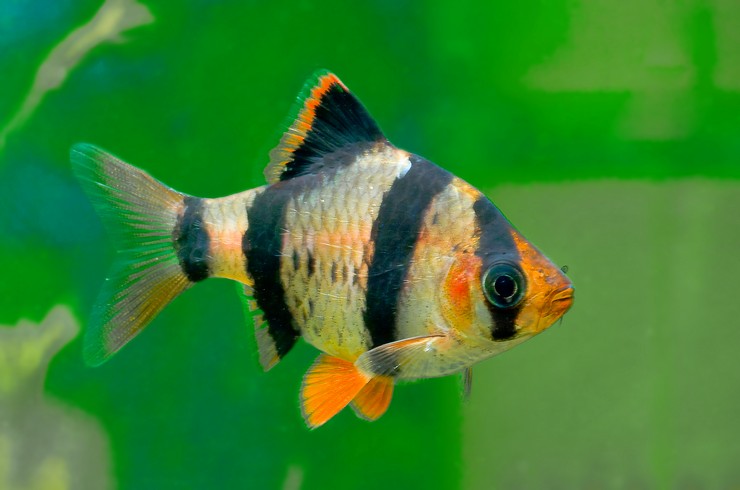
Reproduction and breeding
Breeding a Barbus is not difficult and allows those aquarists who would like to start breeding other species to practice their skills.
For spawning, you will need to select several of the largest and brightest producers and plant them in a separate aquarium, where they are intensively fed with high-protein feed. When the fish are ready for spawning (males have a bright red muzzle, females will noticeably round out), it is necessary to prepare a spawning box with a volume of 10-20 liters. A net is laid at the bottom, and small-leaved plants (Javanese moss, pinnate) is laid on top. The spawning aquarium must be equipped with a filter, heater, and compressor.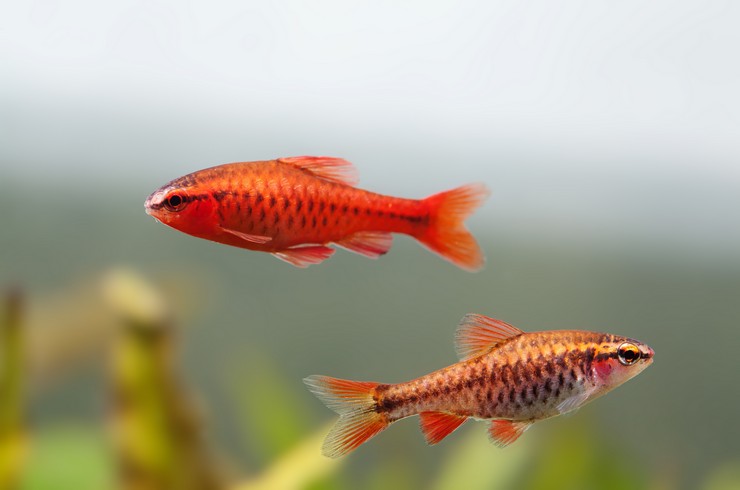
Spawning is stimulated by the addition of soft water and an increase in temperature. It is best to adapt the producers in advance to the parameters that are similar to those in the spawning grounds: T = 26-28 ° C, KN up to 2 °, pH 6.5-7.
When the producers are ready, a female and 2-3 males are planted in the spawning aquarium overnight. The container is darkened. Spawning occurs in the morning and lasts several hours. Males chase the female, she releases portions of eggs, which are immediately fertilized, and fall to the bottom. The fertility of one female can reach up to 1000 eggs.
After the completion of the process, the producers are removed, the eggs are gently shaken off the substrates, the spawning grounds are darkened, after 4 hours the dead, whitened eggs are removed. It is useful to add an antifungal agent to the aquarium to increase potential offspring. The larvae hatch in a day, and on day 3-4, they switch to independent feeding.
